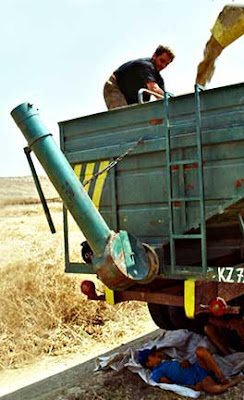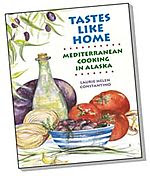Chickens are ever-present in the village. Crowing roosters wake us in the morning. Chickens that have flown the coop stroll the streets at leisure, darting in and out to catch an insect or avoid a passing car. ~~~~~~~~~~~~~~~~~~~~~~~~~~~~~~~~~~ This is my entry for Heart of the Matter, an event to promote heart-healthy eating that is the blogchild of Ilva and Joanna, hosted this month by The Accidental Scientist.
Meandering our way down farm roads, we keep a sharp eye out for chickens. The field birds are free to go wherever they want, which is often scratching dirt in the middle of the road. When you can find the hens’ hidden nests, field chicken eggs are remarkably good. The yolks range from deep gold to bright orange and have wonderful flavor. Making a meal from farm fresh eggs is a treat I never tire of having.
When you can find the hens’ hidden nests, field chicken eggs are remarkably good. The yolks range from deep gold to bright orange and have wonderful flavor. Making a meal from farm fresh eggs is a treat I never tire of having.
As a child of suburban America, the only live chickens I ever saw were in the smelly livestock exhibit at the county fair. For me, chicken meant a smooth pink carcass, wrapped in plastic and stuffed with a bag of giblets.
On one of my early trips to Greece, we got off the plane and drove straight to cousin Froso’s house. She was in her courtyard, up to her elbows in chicken feathers and blood. One of her roosters had been a compulsive crower, so was headed for the pot. Two hens were stacked nearby, waiting to be plucked.
The air surrounding Froso was full of flying feathers, as she deftly and rapidly cleaned the birds. The graphic scene was a far cry from the tidy, factory-cleaned chicken to which I was accustomed.
The day after we saw her plucking it, Froso served us rooster in tomato sauce in honor of our arrival. It was splendid; the rooster was tender and savory and tasted better than any chicken I’d eaten in my life.
Roosters are prized on the island for their full flavor. Long, slow cooking tenderizes the bird, which otherwise would be tough.
Rooster cooked in tomato sauce - Rooster Kokkinistos - is festive fare. It is served on name days (celebrated in Greece and similar to birthdays in America) and to welcome those returning from abroad. Traditional islanders make Rooster Kokkinistos for the August 15 Feast of the Virgin Mary, a major holiday in Greece. Serving long-cooked rooster stew during August heat may seem counter-intuitive. The wheat harvest, however, occurs mid-summer. Chickens gorge on fresh grain left in the fields after combines pass through. By August, they are fat and at their peak of flavor.
Serving long-cooked rooster stew during August heat may seem counter-intuitive. The wheat harvest, however, occurs mid-summer. Chickens gorge on fresh grain left in the fields after combines pass through. By August, they are fat and at their peak of flavor.
Except in the village, we don’t have access to roosters. In Alaska, I make Chicken Kokkinistos using the best quality birds I can find, preferably organic and free range. The aromatic Kokkinistos sauce, rich with tomatoes, onions, and cinnamon, enhances the mild flavor of supermarket chicken. Its flavors spirit me back to the village. Chicken Kokkinistos with Potatoes [Πετ’νός (Κόκορας) Κοκκινιστός με Πατάτες]
Chicken Kokkinistos with Potatoes [Πετ’νός (Κόκορας) Κοκκινιστός με Πατάτες]
Serves 6 - 8
Adapted from Συνταγές Λημνιακής Κουζίνας by Ουρανία Βαγιάκου (Athens 2000)
Thin egg noodles can be substituted for potatoes in this dish. Simply add uncooked noodles to the sauce for the last 15 minutes, and simmer until the noodles are done, adding water if necessary. The amount of cinnamon called for in the recipe is just enough to add flavor without overwhelming the sauce. I prefer using spicy “Saigon” cinnamon in this savory dish; standard supermarket cinnamon is fine, although its flavor is milder. “Saigon” cinnamon is sold by specialty spice sellers and upscale supermarket brands. It’s important to remove the whole cloves before serving Chicken Kokkinistos; they are not pleasant to bite into. You can wrap the cloves in cheesecloth before adding to the sauce to make them easier to remove. I rarely take the time to do so; I count the number of cloves and fish around in the sauce until I account for them all.
3 - 3 1/2 pound chicken, cut up or 3 pounds chicken thighs
Salt
Freshly ground black pepper
1/2 cup olive oil, divided
4 cups diced yellow onions, 1/4” dice
2 Tbsp. minced garlic
2 cups dry white wine
3 cups, or 2 14.5-ounce cans, diced tomatoes with their juices
3 cups water
3 bay leaves
6 whole cloves
1 tsp. cinnamon, preferably Vietnamese Cassia "Saigon" Cinnamon
1 tsp. sugar
2 pounds potatoes, preferably red or Yukon Gold
Wash and dry the chicken well. Season the pieces on both sides with salt and freshly ground black pepper.
Heat 1/4 cup olive oil in a large pot until it’s very hot but not smoking (if oil is very hot, chicken skin is less likely to stick to the pan). Place the chicken in the pot, skin side down, and let cook until it’s well browned. Turn over and brown the other side of the chicken. Brown the chicken in batches; don’t try to crowd all the chicken into the pot at one time or the chicken will steam rather than brown.
Remove the chicken from the pot, and pour off most of the oil, leaving only enough to sauté the onions. Cook the onions in the remaining oil until they soften and begin to turn golden, scraping up any browned bits on the bottom of the pot. Add the garlic and cook for 1 minute.
Add the wine, and cook until it is reduced by half. Stir in the tomatoes and their juices, water, bay leaves, cloves, cinnamon, and sugar. Return the chicken to the pot, submerging it in the sauce. Bring the sauce to a boil, reduce heat to low, and simmer uncovered for 45 minutes. Taste and add cinnamon, as needed.
While the chicken is cooking, peel the potatoes, cut them into large chunks, and season with salt and freshly ground black pepper. Fry batches of potatoes in the remaining 1/4 olive oil until they are nicely browned on all sides, but not cooked through. Remove potatoes from the oil and drain on paper towels.
After the chicken has cooked for 45 minutes, remove the 6 whole cloves from the sauce. Stir in the browned potatoes and cook for 15 minutes, or until the potatoes are cooked, the chicken is tender, and the sauce has thickened. Taste and add salt or freshly ground black pepper, as needed.
Serve with a crisp green salad, slices of feta cheese, black olives, and crusty bread.
Saturday, February 16, 2008
Greek Village Feasting: Chicken Kokkinistos [Πετ’νός (Κόκορας) Κοκκινιστός με Πατάτες]
Subscribe to:
Post Comments (Atom)




15 comments:
Laurie, what a lovely story, pictures and recipe!!! I know what you are talking about: my parents used to have a little house in the country side and had roosters and hens. I remember one agresive rooster called Falconety that ended up in the pot.... Soooooo gooooood! :D Their meat and taste is so different from the ones you buy in the supermarket.
That is a lovely story! Stewed rooster for honored guests sounds like a heart warming tradition, especially when the guests are you!
This is a lovely story Laurie and we have it a lot (in my husband's family they prepare it with red wine - kokoras krasatos) but to be frank I don't cook this often. Cinnamon is a must in these kinds of Greek dishes and I love cinnamon.
I love those bright orange yolks that stand up! In the winter my supply stops as the person I buy from has fewer eggs. Apparently chickens lay less in the cold. My mom tells a story of how her pet "Benny the rooster" was served up for dinner one night. It's hilarious how the kids reacted :)
A great post on Kokkoro and I too have witnessed the dispathing of poultry in the Xorio.
Kokkinisto dishes are enjoyed all across Greece...because they taste that good!
Nuria, somehow food from the country often tastes better than city food - don't you feel lucky to have experienced it? I know I do!
Lannae, definitely true when you are the guest! Glad you liked the story.
Ivy, Kokoras Krasatos is also delicious and I'd be very happy if someone would cook it for me! I agree with you about cinnamon - it goes really well with the flavor of tomatoes.
Maryann, poor Benny! You're lucky to have access to farm eggs on a regular basis - and I too love the way the yolks stand up proud.
Peter M, yes they do. Taste good that is. Especially when made with rooster.
Laurie, this dish looks outrageously good! I loved the photo of the coloured chickens - the red ones in particular are very handsome.
That dinner looks amazing! Chicken and potatoes in a tasty gravy with feta, olives and bread...mmm...
I am a kid from the city so never have had the opportunity to eat rooster from the pot. It just sounds so flavourful :D I still have a lot of living to do :D
Love this story -- it must be such a blessing to have a warm Greek island to reminisce about on cold cold Alaska days . . .
There are feral roosters on Oahu, and your story has made me look at them a lit-t-t-le differently now. I used to see them just as colorful, if noisy, part of the landscape. But now there are stew-pot possibilities preening and clucking in the parking lots of the North Shore!!
Gaye, I agree, the red chicken against the green wheat is very handsome.
Kevin, mmm indeed. The only thing better than making it is eating it when someone else is the cook!
Val, I hope we ALL have a lot of living to do! That's my plan anyway...
Manju, I'd love to see a video of you and T trying to take out a feral rooster - now that would be a sight to behold! I checked out this article about Oahu's feral roosters: http://starbulletin.com/2007/01/28/news/story02.html It says "roosters caught healthy are eventually cooked [by people] in search of a meal free of steroids or preservatives." Sounds good to me.
where does the crusty bread come from? looks very greek to me
Love your stories... and the chicken are so beautiful!
Wonderful evocative post! And that meal looks wonderful.
I kept chickens in another life and loved it. We did fence them in, but it was a very large area that they shared with a couple of goats, so I suppose they were semi-free range. We had a very aggressive rooster named Sparky who routinely terrorized smaller-sized people. They only way to make him back off was to chase him around flapping our arms and making "Whoop! Whoop!" sounds. :-) But my, the eggs were awesome...
I love savory dishes flavored with sweet spices like cinnamon and cloves. There's a chicken (sadly, not a rooster) in my kitchen that now has this recipe's name on it.
Post a Comment